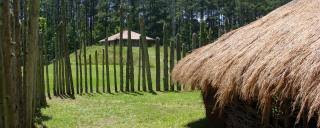The chance to find an ancient culture seems like an adventure worth pursuing. Imagine exploring the political and ceremonial center of a complex society that engaged in widespread trade, supported craft specialists, and built earthen mounds for spiritual and political leaders.
Early Civilization
The mysteries of past centuries and an early civilization are hidden in plain sight, but visible if you venture to Town Creek Indian Mound near the town of Mount Gilead in southwestern Montgomery County, NC.The only state historic site in North Carolina dedicated to Native American heritage, Town Creek offers a glimpse into how people lived here well before the arrival of Europeans and Africans in an era known as “pre-Columbian,” or before Columbus first crossed the Atlantic Ocean in 1492.
Several thousand years earlier, Native peoples began settling in permanent villages near rivers. When they stopped their nomadic lifestyles to search for wild foods, they planted plots of squash, corns, beans, and other produce and made pottery with clay from riverbanks.
Archeological Evidence
Around 1100, these societies began building ceremonial centers, some surrounded by stockades. Town Creek represents such a center, although it has largely been reconstructed using archeological evidence. Scholarly research and archeology have been conducted there for more than half a century. Excavations first began in 1937, when the site was acquired by the state, and still continue today, although on only a limited basis. Because these people left no written record, archeology has been vital to uncover their history.When I first visited Town Creek and saw the palisade, or fence of wooden stakes, that surrounds the site, it reminded me of stockades built in the 1600s at Jamestown and other colonial settlements. However, entering inside lets you know that you are experiencing a much earlier history when survival might have been even more difficult. Archaeological evidence indicates that the palisade was rebuilt at least five times.
The open area inside Town Creek made me think of parade grounds in early U.S. coastal forts such as Fort Sumter in the harbor of Charleston, S.C., or open plazas typical of cities designed by the Spanish and best illustrated in the South by the one in Saint Augustine, FL. However, these sites don’t have a huge ceremonial mound as their centerpiece.
The mound at Town Creek was actually the site of three separate structures: first an earthen lodge, then a temple built over the lodge after it had collapsed with age, and finally a ceremonial structure that had a ramp leading to a large plaza or public area where societal meetings and ceremonial activities took place. Around the edge of the plaza, several structures that served as burial or mortuary houses containing graves of a clan were built.
Graves of the elite were decorated with treasured relics, such as copper from the Great Lakes region and conch shells from the coast, that reflected their status in society. Some graves included medicine bundles as well as pots of food for the voyage to the afterlife. Learning that 563 burials have been found at Town Creek captivated me more than seeing the burial artifacts.
Cultural Traditions
In addition to being a burial site, Town Creek was also where socially high-ranking members lived and important matters were discussed among collective clans of the society. It was also the scene of tribal feasts as well as important religious events, including annual purification ceremonies.After extinguishing all fires in their homes, people from outlying villages came to Town Creek and participated in ceremonial bathing, took “cleansing” medicines, and ate corn to prepare for each new year. When the annual ceremonies ended, villagers returned home to relight their hearths with embers from a sacred fire to symbolize unity with each other. Sharing the fire fostered the idea that they were “people of one fire.”
Town Creek was abandoned around 1400 when the Pee Dee adopted a more egalitarian social structure. Priestly temples atop mounds that reflected government by an elite fell into disuse. As large council houses were created to conduct government by consensus, burial practices changed as well.
The site is a popular destination for field trips by schoolchildren. “It’s fun to see how amazed they are when they walk through the guard tower and see what a village once looked like. It’s like stepping back in time,” says Rich Thompson, site manager. He estimates that about 12,000 children on school field trips visit each year, some from as far away as Ocracoke Island on the Outer Banks and others from neighboring states.
The oldest state historic site, Town Creek Indian Mound has several special events throughout the year that focus on archaeology and explore the lifestyle of the Native peoples, known as “Pee Dee,” who are not culturally connected to familiar regional groups such as Lumbee, Catawba and Cherokee but were influenced by a different tradition known as South Appalachian Mississippian. Learning more about an ancient culture is definitely an adventure worth pursuing
Note: The post is based on my article about Town Creek published in the March 2019 issue of OutreachNC Magazine.






